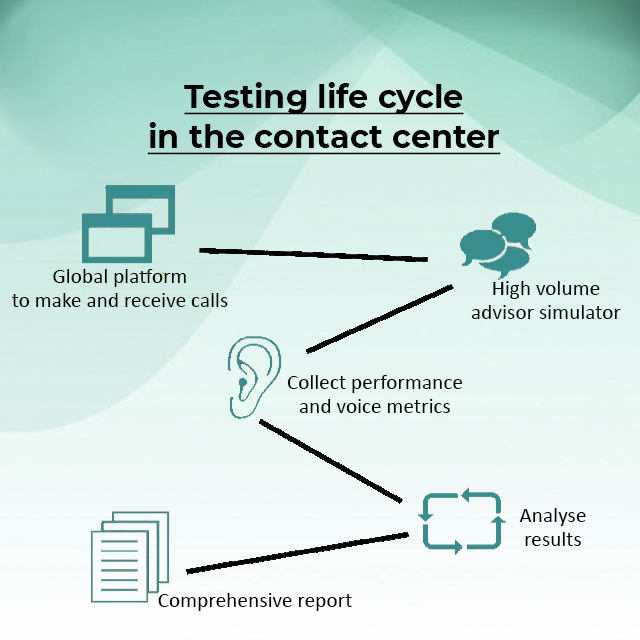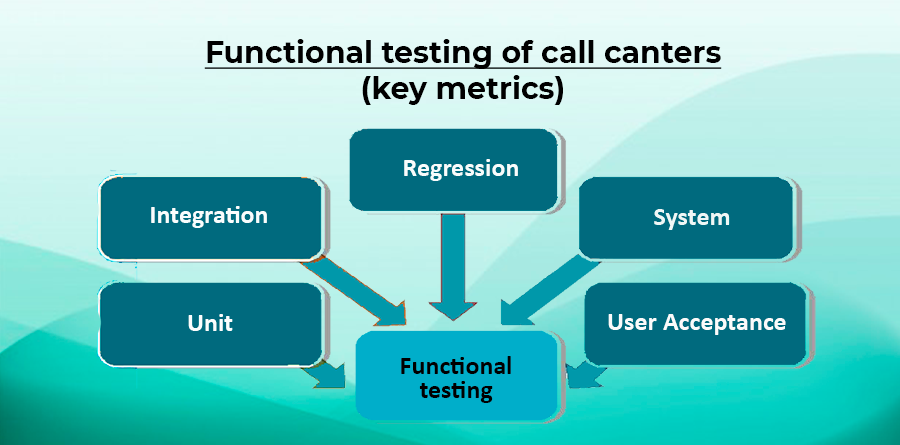In today’s world, companies have to correspond to the potential clients’ expectations in the context of personalized servicing of user requests.
Therefore, any organization which directly works with clients needs a special system that helps to meet all the high standards of service and competition with other firms. All this is for business success and prosperity.
The General Concept of Contact Center
A contact center is a special system which can make a direct connection between a company and a client. Such a center’s staff solves all incoming tasks, helps to generate expected results and is aimed to satisfy the client’s requests.
In order to have a constant and stable connection with the clients, the contact center should use qualitative and proven technical system which can work under any business conditions. Executing testing in a contact center is key to effective and successful work.
Concept of Contact Center Testing
So, first of all, we need to specify what is the contact center in the testing context.
Contact center is a central place, a platform for quick and easy client-company interaction. It controls all the outgoing and incoming client requests.
Any contact center consists of several call-centers. Despite the fact that both these platforms are aimed to serve the clients, contact centers have more services and functions than call-center.
Contact Center Testing
Contact center testing is a quite important process which is mandatory when new platforms are deployed or technical logic of the platform is changed. In the future, it will help to deploy new functions which improve the quality of client base maintenance.

Testing life cycle in the contact center
Testing in the contact center is a kind of testing which is performed in order to thoroughly study the performance of all the accessing and moving points inside some system platform.
A test suite is executed to check the whole cycle of client-system interaction. And it consists of the following components:
- Incoming call routing to the active agents;
- Checking of the available and inoperable transmission links;
- Conformity of testing infrastructure logic with the technologies and requests of the call center;
- Other factors.
Basic moments which you should take into account before the test execution:
- Generating of incoming and outgoing information;
- Agent functions while interacting with all available software in the contact center;
- Agent interaction with several clients;
- Transferring the incoming calls to the particular agent;
- Creating a support team: operator, administrator, and system administrator;
- Deployment of new center capabilities;
- Hierarchical diversity of groups and waiting lines of customer support.
Before testing the level of system performance, it is important to understand, what is the amount of the information you need to interact with and how to properly cover it with the tests.
It is not necessary to execute performance tests of those moments which are used really seldom and after a few related situations. But no doubt, those system parts that are used regularly should be tested thoroughly and qualitatively.
Beginning of the testing
In order to see what technical structures you should test in the first place, you need to take into account the following factors:
- Firstly, it’s a number of clients who can work on the line simultaneously;
- Also, a number of incoming calls;
- Agent operation speed and current Internet connection;
- Amount of calls that the agent can process per 1 hour;
- Finally, the total amount of matches received.
Peculiarities of Contact Center Testing
Quality assurance organizations that perform such functional testing, place greater importance to these activities. Because only exhaustive and independent testing allows analyzing effectively the system functioning and its components which are integrated into the software.
Obviously, contact center testing is based on 2 kinds of testing.
Functional Testing Performance
QA engineers perform such a kind of testing at the different stages of contact center functioning in order to test the current platform efficiency.
There are such phases:
- System integration testing. Testers perform it after software integration to see if the system works properly in a live situation.
- Component testing. It is testing of deployed elements or parts of the system. Such testing has a restricted approach and is quite important during the interaction with other testing methods.
- Usability testing. It estimates the satisfaction level of the customers after interacting with the system. Moreover, it helps to see if the client gets all that he/she wants from the software parameters.
- User acceptance testing. This is the process of testing the system apps performance according to pre-validated standards and criteria.

Functional testing of call canters
Performance Test Execution
QA engineers execute performance testing to identify correctly the speed, response time, and potentially tested system scalability. They usually perform it at the beginning and at the end of the software development process.
Performance tests include:
- Load test cases. They allow finding weak and critical spots in the web product performance. Also, testers execute these checks in order to see the potentially maximum system load under unexpected and critical conditions.
- General performance testing. It allows defining software response time under negative conditions such as program failure, data generation extinction, lost Internet connection.
- Fallback recovery test. It is necessary to test the time needed for backup restoring. It also helps to see if the system can work properly if some elements have been deleted or stopped.
Toolset for Contact Center Testing
As far as every company has its own contact and call centers, they use different programs for their technical needs.
Experiences of many companies prove that the most qualitative and effective testing tools for such software are the following ones:
- STAMP;
- CYARA;
- HAMMER.
Further, we will analyze contact center testing with the help of STAMP.
What is STAMP?
STAMP (System test and monitoring platform) is a set of technologies for full test automation and control of user experience.
This tool allows making some preliminary steps for configuration of different test kinds. As an aside, DevOps community became the first group from the IT world that began to use this tool.
A lot of specialists such as QA engineers, IT developers, DevOps groups use STAMP. It helps to reach the necessary performance in real-time mode, send system notifications, and generate detailed reports.
Peculiarities of STAMP:
- Test scripts are really flexible and you can copy them for multiple usages;
- STAMP tests help to see that the tested system will be performing properly and stable in the future;
- Of course, these technologies allow reducing the load on enterprise transaction costs;
- STAMP includes all aspects of automated tests and allows optimizing the level of contact center-user interaction. Moreover, it solves a problem with the quality and speed of service.
Conclusion
Specialists constantly improve contact center technologies for positive influence on interaction with clients and satisfying all the incoming requests as well.
Contact center testing is not just a typical test suite for measuring the connection quality. Nevertheless, it is a global testing framework for all system solutions that are complementary.
It is highly important to follow the correct and relevant testing standards in order to manage effective architecture and meet the determined clients’ requirements.










Leave A Comment